英语基础语法最全-含练习题-分类清晰
初中八年级英语常用语法知识——动词基础练习(含答案解析)
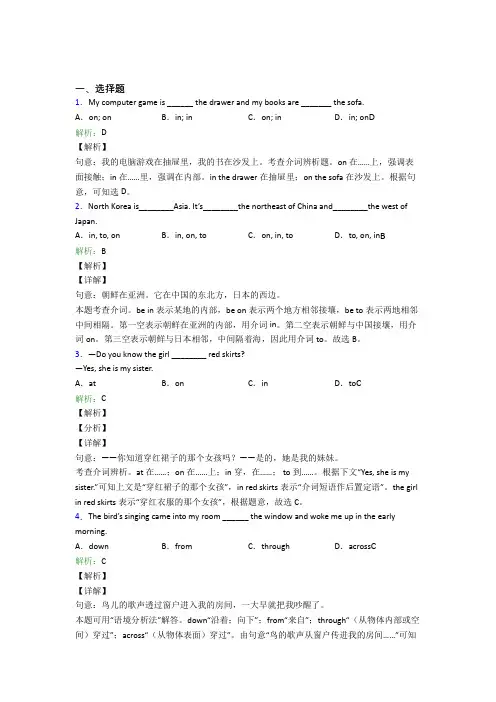
一、选择题1.My computer game is ______ the drawer and my books are _______ the sofa.A.on; on B.in; in C.on; in D.in; on D解析:D【解析】句意:我的电脑游戏在抽屉里,我的书在沙发上。
考查介词辨析题。
on在……上,强调表面接触;in在……里,强调在内部。
in the drawer在抽屉里;on the sofa在沙发上。
根据句意,可知选D。
2.North Korea is________Asia. It’s________the northeast of China and________the west of Japan.A.in, to, on B.in, on, to C.on, in, to D.to, on, in B解析:B【解析】【详解】句意:朝鲜在亚洲。
它在中国的东北方,日本的西边。
本题考查介词。
be in表示某地的内部,be on表示两个地方相邻接壤,be to表示两地相邻中间相隔。
第一空表示朝鲜在亚洲的内部,用介词in。
第二空表示朝鲜与中国接壤,用介词on。
第三空表示朝鲜与日本相邻,中间隔着海,因此用介词to。
故选B。
3.—Do you know the girl ________ red skirts?—Yes, she is my sister.A.at B.on C.in D.to C解析:C【解析】【分析】【详解】句意:——你知道穿红裙子的那个女孩吗?——是的,她是我的妹妹。
考查介词辨析。
at在……;on在……上;in穿,在……; to到……。
根据下文“Yes, she is my sister.”可知上文是“穿红裙子的那个女孩”,in red skirts表示“介词短语作后置定语”。
the girl in red skirts表示“穿红衣服的那个女孩”,根据题意,故选C。
初中英语语法大全(含练习)30页
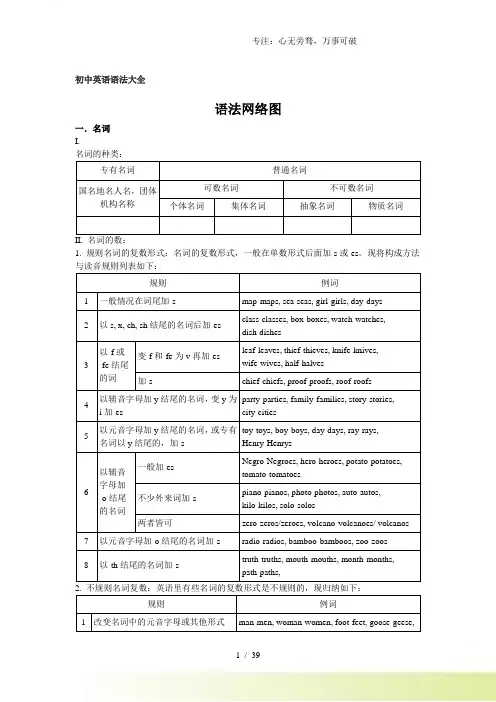
初中英语语法大全语法网络图一.名词I.专有名词普通名词国名地名人名,团体机构名称可数名词不可数名词个体名词集体名词抽象名词物质名词II. 名词的数:1. 规则名词的复数形式:名词的复数形式,一般在单数形式后面加-s或-es。
现将构成方法规则例词1一般情况在词尾加-s map-maps, sea-seas, girl-girls, day-days2以s, x, ch, sh结尾的名词后加-es class-classes, box-boxes, watch-watches, dish-dishes3以-f或-fe结尾的词变-f和-fe为v再加-esleaf-leaves, thief-thieves, knife-knives,wife-wives, half-halves加-s chief-chiefs, proof-proofs, roof-roofs4以辅音字母加y结尾的名词,变y为i加-esparty-parties, family-families, story-stories,city-cities5以元音字母加y结尾的名词,或专有名词以y结尾的,加-stoy-toys, boy-boys, day-days, ray-rays,Henry-Henrys6以辅音字母加-o结尾的名词一般加-esNegro-Negroes, hero-heroes, potato-potatoes,tomato-tomatoes不少外来词加-spiano-pianos, photo-photos, auto-autos,kilo-kilos, solo-solos两者皆可zero-zeros/zeroes, volcano-volcanoes/ volcanos7以元音字母加-o结尾的名词加-s radio-radios, bamboo-bamboos, zoo-zoos8以-th结尾的名词加-s truth-truths, mouth-mouths, month-months, path-paths,规则例词1改变名词中的元音字母或其他形式man-men, woman-women, foot-feet, goose-geese,mouse-mice2单复数相同sheep, deer, means, works, fish, yuan, jin, 3只有复数形式trousers, clothes, thanks, goods, glasses, 4一些集体名词总是用作复数people, police5部分集体名词既可以作单数(整体)也可以作复数(成员)class, family, crowd, couple, group, government,population, team, public, party6复数形式表示特别含义customs(海关), times(时代), spirits(情绪), drinks(饮料), sands(沙滩), papers(文件报纸), looks(外表), brains(头脑智力), greens(青菜)7表示“某国人”加-sAmericans, Australians, Germans, Greeks,Swedes, Europeans单复数同形Swiss, Portuguese, Chinese, Japanese以-man或-woman结尾的改为-men,-womenEnglishmen, Frenchwomen8合成名词将主体名词变为复数sons-in-law, lookers-on, passers-by, story-tellers,boy friends无主体名词时将最后一部分变为复数grown-ups, housewives, stopwatches 将两部分变为复数women singers, men servantsIII. 名词的所有格:名词在句中表示所有关系的语法形式叫做名词所有格。
初中英语语法基础知识大全100题
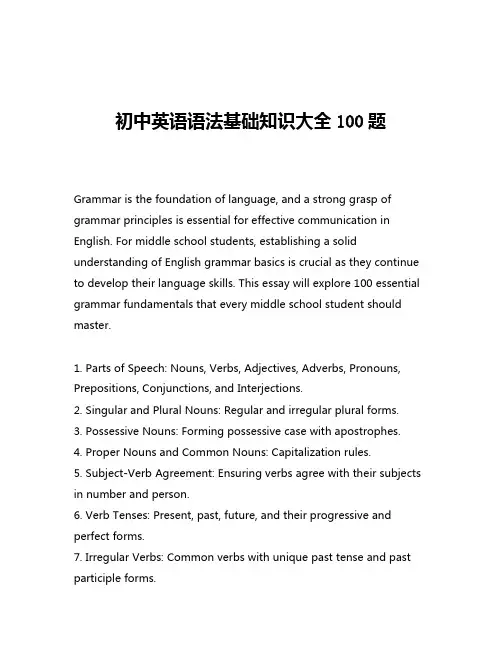
初中英语语法基础知识大全100题Grammar is the foundation of language, and a strong grasp of grammar principles is essential for effective communication in English. For middle school students, establishing a solid understanding of English grammar basics is crucial as they continue to develop their language skills. This essay will explore 100 essential grammar fundamentals that every middle school student should master.1. Parts of Speech: Nouns, Verbs, Adjectives, Adverbs, Pronouns, Prepositions, Conjunctions, and Interjections.2. Singular and Plural Nouns: Regular and irregular plural forms.3. Possessive Nouns: Forming possessive case with apostrophes.4. Proper Nouns and Common Nouns: Capitalization rules.5. Subject-Verb Agreement: Ensuring verbs agree with their subjects in number and person.6. Verb Tenses: Present, past, future, and their progressive and perfect forms.7. Irregular Verbs: Common verbs with unique past tense and past participle forms.8. Active Voice and Passive Voice: Recognizing and using both constructions.9. Transitive and Intransitive Verbs: Verbs that require objects and those that do not.10. Linking Verbs: Verbs that connect the subject to a subject complement.11. Auxiliary Verbs (Helping Verbs): Verbs that assist the main verb, such as "be," "have," and "do."12. Modal Auxiliaries: Verbs that express possibility, obligation, permission, and other modalities.13. Gerunds and Infinitives: Verbal forms that function as nouns, adjectives, or adverbs.14. Adjective Types: Descriptive, possessive, demonstrative, interrogative, and articles.15. Degrees of Comparison: Positive, comparative, and superlative forms of adjectives.16. Adverb Types: Manner, time, place, frequency, degree, and sentence adverbs.17. Comparative and Superlative Adverbs: Forming adverb comparisons.18. Personal Pronouns: Subject, object, possessive, and reflexive forms.19. Indefinite Pronouns: Words like "someone," "anyone," "nothing," and "all."20. Relative Pronouns: "Who," "whom," "whose," "which," and "that."21. Interrogative Pronouns: "Who," "what," "where," "when," "why," and "how."22. Preposition Types: Prepositions of time, place, direction, and relationship.23. Prepositional Phrases: Identifying and using prepositional phrases correctly.24. Coordinating Conjunctions: "And," "but," "or," "nor," "for," "so," and "yet."25. Subordinating Conjunctions: "Because," "since," "when," "while," "if," and "unless."26. Correlative Conjunctions: Paired conjunctions like "both...and," "either...or," and "neither...nor."27. Interjections: Expressing emotion or emphasis, such as "Ouch!" and "Wow!"28. Sentence Types: Declarative, interrogative, imperative, and exclamatory sentences.29. Simple Sentences: One independent clause with a subject and a verb.30. Compound Sentences: Two or more independent clauses joined by a coordinator.31. Complex Sentences: An independent clause and one or more dependent clauses.32. Compound-Complex Sentences: Combining compound and complex sentence structures.33. Phrases: Noun phrases, verb phrases, adjective phrases, andadverb phrases.34. Clauses: Independent clauses and dependent clauses.35. Dangling and Misplaced Modifiers: Recognizing and correcting these common errors.36. Parallel Structure: Maintaining consistency in the grammatical form of related elements.37. Sentence Fragments: Identifying and correcting incomplete sentences.38. Run-On Sentences: Recognizing and fixing two or more independent clauses joined incorrectly.39. Subject-Verb Inversion: Inverting the subject and verb in certain sentence structures.40. Negation: Forming negative statements using "not," "no," and other negating words.41. Contractions: Combining words to form shortened forms, such as "can't" and "won't."42. Capitalization Rules: When to capitalize proper nouns, titles, and the beginning of sentences.43. Punctuation: Using periods, commas, semicolons, colons, apostrophes, and quotation marks correctly.44. Appositives: Noun phrases that rename or describe another noun.45. Participial Phrases: Verb phrases that function as adjectives or adverbs.46. Gerund Phrases: Noun phrases beginning with a gerund.47. Infinitive Phrases: Verb phrases beginning with an infinitive.48. Restrictive and Nonrestrictive Clauses: Defining and nondefining relative clauses.49. Conditional Sentences: "If-then" statements expressing hypothetical situations.50. Passive Voice Transformation: Changing active voice sentences to passive voice.51. Direct and Indirect Speech: Reporting statements, questions, and commands.52. Pronoun-Antecedent Agreement: Ensuring pronouns agree with their antecedents.53. Pronoun Case: Subjective, objective, and possessive pronoun forms.54. Reflexive and Intensive Pronouns: Using "self" and "selves" pronouns correctly.55. Demonstrative Pronouns: "This," "that," "these," and "those."56. Indefinite Pronouns: "Everyone," "someone," "anything," and "nothing."57. Relative Pronouns: "Who," "whom," "whose," "which," and "that."58. Interrogative Pronouns: "Who," "what," "which," "whose," and "whom."59. Preposition Placement: Appropriate positioning of prepositions in sentences.60. Conjunction Usage: Selecting the right coordinating or subordinating conjunction.61. Adverb Placement: Properly positioning adverbs within asentence.62. Adjective Order: Following the correct order when using multiple adjectives.63. Verb Tense Consistency: Maintaining consistent verb tense throughout a passage.64. Subjunctive Mood: Using "were" instead of "was" in certain hypothetical statements.65. Gerund vs. Infinitive: Choosing between gerund and infinitive verb forms.66. Active vs. Passive Voice: Determining the appropriate voice for a given sentence.67. Subject-Verb Agreement with Collective Nouns: Singular or plural verb form.68. Compound Subject Agreement: Ensuring correct verb agreement with compound subjects.69. Dangling Modifiers: Correcting sentence structures with unclear modifications.70. Misplaced Modifiers: Placing modifiers in the appropriate position in a sentence.71. Parallel Structure in Lists: Maintaining grammatical consistency ina series of items.72. Comma Usage: Properly using commas in a variety of sentence structures.73. Semicolon Usage: Correctly applying semicolons to join independent clauses.74. Colon Usage: Appropriately using colons to introduce lists or explanations.75. Apostrophe Usage: Proper placement of apostrophes in possessive forms and contractions.76. Quotation Mark Usage: Correctly incorporating quotations and dialogue.77. Capitalization Rules: Applying capitalization guidelines for proper nouns, titles, and more.78. Abbreviation and Acronym Usage: Correctly using abbreviated forms and acronyms.79. Numbers and Numerals: Deciding when to spell out numbers versus using numerals.80. Commonly Confused Words: Distinguishing between homophones and similar-sounding words.81. Idioms and Idiomatic Expressions: Understanding and using common English idioms.82. Preposition Combinations: Mastering the appropriate prepositions to use in various contexts.83. Relative Clause Placement: Ensuring relative clauses are positioned correctly.84. Noun Clause Structure: Constructing noun clauses as subjects, objects, and complements.85. Adverb Clause Structure: Forming adverb clauses to provide additional information.86. Adjective Clause Structure: Creating adjective clauses to modifynouns and pronouns.87. Conditional Clause Structure: Constructing "if-then" statements and other conditional sentences.88. Passive Voice Transformation: Converting active voice sentences to passive voice.89. Direct and Indirect Speech: Accurately reporting statements, questions, and commands.90. Pronoun-Antecedent Agreement: Ensuring pronouns agree with their antecedents in number and gender.91. Pronoun Case: Properly using subjective, objective, and possessive pronoun forms.92. Reflexive and Intensive Pronouns: Identifying and applying the correct "self" pronouns.93. Demonstrative Pronouns: Appropriately using "this," "that," "these," and "those."94. Indefinite Pronouns: Recognizing and using universal, existential, and negative pronouns.95. Relative Pronouns: Selecting the right relative pronoun ("who," "whom," "whose," "which," "that").96. Interrogative Pronouns: Employing "who," "what," "which," "whose," and "whom" correctly.97. Preposition Placement: Ensuring prepositions are positioned properly in sentences.98. Conjunction Usage: Choosing the appropriate coordinating or subordinating conjunction.99. Adverb Placement: Determining the correct placement of adverbs within a sentence.100. Adjective Order: Arranging multiple adjectives in the proper sequence.Mastering these 100 essential grammar fundamentals will provide middle school students with a strong foundation in English language skills. By understanding the rules and conventions governing parts of speech, sentence structures, punctuation, and more, students can improve their written and oral communication, as well as their reading comprehension. Continuous practice and reinforcement of these grammar principles will equip middle school students for success in their academic and professional pursuits.。
人教版三年级英语语法基础练习题30题含答案解析
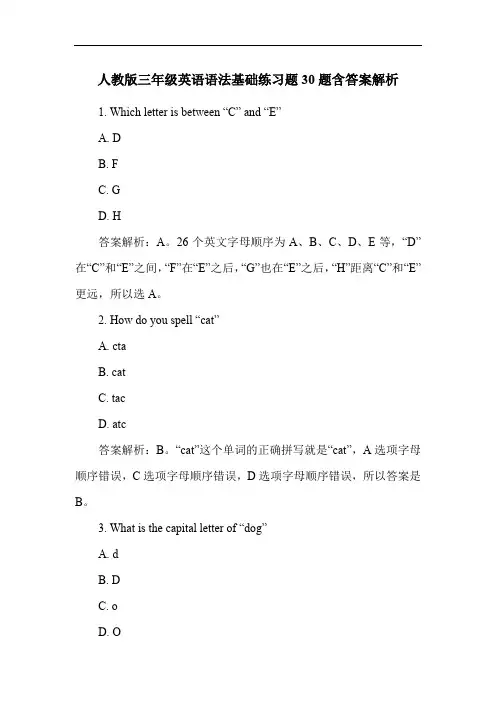
人教版三年级英语语法基础练习题30题含答案解析1. Which letter is between “C” and “E”A. DB. FC. GD. H答案解析:A。
26个英文字母顺序为A、B、C、D、E等,“D”在“C”和“E”之间,“F”在“E”之后,“G”也在“E”之后,“H”距离“C”和“E”更远,所以选A。
2. How do you spell “cat”A. ctaB. catC. tacD. atc答案解析:B。
“cat”这个单词的正确拼写就是“cat”,A选项字母顺序错误,C选项字母顺序错误,D选项字母顺序错误,所以答案是B。
3. What is the capital letter of “dog”A. dB. DC. oD. O答案解析:B。
“dog”这个单词的首字母大写形式是“D”,A选项是小写形式,C选项不是首字母,D选项虽然是大写但不是首字母,所以选B。
4. Which letter is the fifth in the alphabetA. EB. FC. GD. H答案解析:A。
26个英文字母中,按照顺序数第五个字母是“E”,“F”是第六个,“G”是第七个,“H”是第八个,所以答案是A。
5. How do you spell “pen”A. nepB. penC. pneD. enp答案解析:B。
“pen”的正确拼写是“pen”,A选项字母顺序错误,C选项字母顺序错误,D选项字母顺序错误,所以选B。
6. Which letter is not a vowelA. AB. EC. FD. I答案解析:C。
在26个英文字母中,元音字母是A、E、I、O、U,“F”不是元音字母,所以答案是C。
7. What is the capital letter of “apple”A. aB. AC. pD. P答案解析:B。
“apple”的首字母大写是“A”,A选项是小写,C选项不是首字母,D选项虽然大写但不是首字母,所以答案是B。
英语语法讲解及练习大全(附答案)
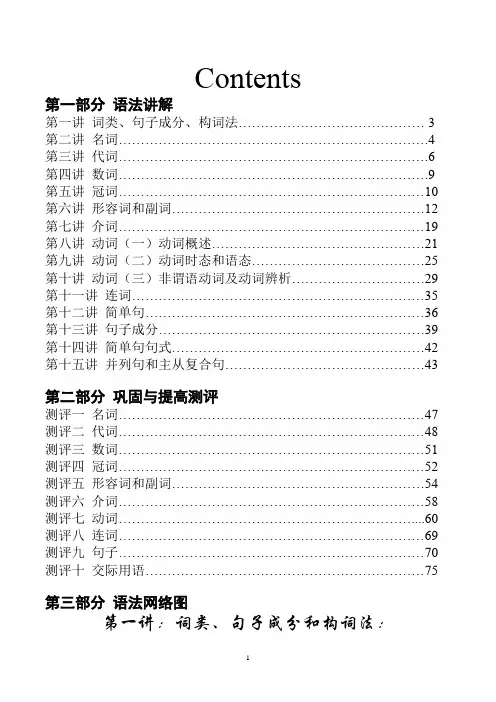
Contents第一部分语法讲解第一讲词类、句子成分、构词法 (3)第二讲名词 (4)第三讲代词 (6)第四讲数词 (9)第五讲冠词 (10)第六讲形容词和副词 (12)第七讲介词 (19)第八讲动词(一)动词概述 (21)第九讲动词(二)动词时态和语态 (25)第十讲动词(三)非谓语动词及动词辨析 (29)第十一讲连词 (35)第十二讲简单句 (36)第十三讲句子成分 (39)第十四讲简单句句式 (42)第十五讲并列句和主从复合句 (43)第二部分巩固与提高测评测评一名词 (47)测评二代词 (48)测评三数词 (51)测评四冠词 (52)测评五形容词和副词 (54)测评六介词 (58)测评七动词 (60)测评八连词 (69)测评九句子 (70)测评十交际用语 (75)第三部分语法网络图第一讲:词类、句子成分和构词法:2、代词(pron.):主要用来代替名词。
如:who, she, you, it .3、形容词(adj..):表示人或事物的性质或特征。
如:good, right, white, orange .4、数词(num.):表示数目或事物的顺序。
如:one, two, three, first, second, third, fourth.5、动词(v.):表示动作或状态。
如:am, is,are,have,see .6、副词(adv.):修饰动词、形容词或其他副词,说明时间、地点、程度等。
如:now, very, here, often, quietly, slowly.7、冠词(art..):用在名词前,帮助说明名词。
如:a, an, the.8、介词(prep.):表示它后面的名词或代词与其他句子成分的关系。
如in, on, from, above, behind.9、连词(conj.):用来连接词、短语或句子。
如and, but, before .10、感叹词(interj..)表示喜、怒、哀、乐等感情。
英语语法基础知识(适用于初高中衔接)1
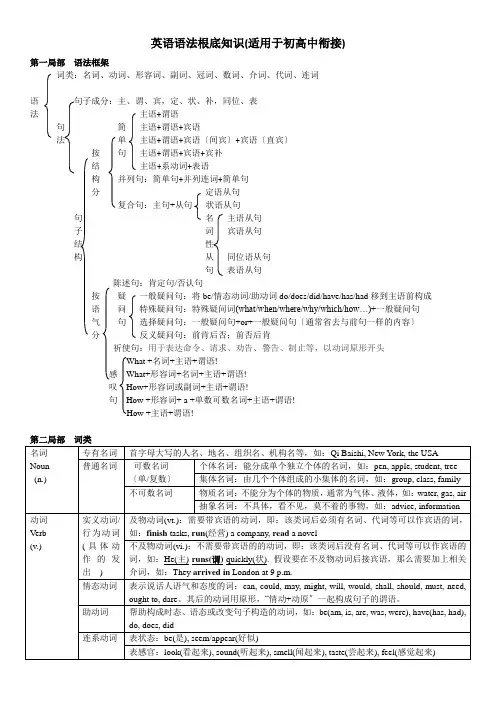
英语语法根底知识(适用于初高中衔接)第一局部语法框架词类:名词、动词、形容词、副词、冠词、数词、介词、代词、连词语句子成分:主、谓、宾,定、状、补,同位、表法主语+谓语句简主语+谓语+宾语法单主语+谓语+宾语〔间宾〕+宾语〔直宾〕按句主语+谓语+宾语+宾补结主语+系动词+表语构并列句:简单句+并列连词+简单句分定语从句复合句:主句+从句状语从句句名主语从句子词宾语从句结性构从同位语从句句表语从句陈述句:肯定句/否认句按疑一般疑问句:将be/情态动词/助动词do/does/did/have/has/had移到主语前构成语问特殊疑问句:特殊疑问词(what/when/where/why/which/how…)+一般疑问句气句选择疑问句:一般疑问句+or+一般疑问句〔通常省去与前句一样的内容〕分反义疑问句:前肯后否;前否后肯祈使句:用于表达命令、请求、劝告、警告、制止等,以动词原形开头What +名词+主语+谓语!感What+形容词+名词+主语+谓语!叹How+形容词或副词+主语+谓语!句How +形容词+ a +单数可数名词+主语+谓语!How +主语+谓语!第三局部句子成分及简单句一、简单句的五大根本句型:主语+ 谓语名词/代词/动名词/不定式+ 不及物动词主语+ 谓语+ 宾语名词/代词/动名词/不定式+ 及物动词+ 名词/代词/动名词/不定式主语+ 谓语+ 宾语〔间宾〕+ 宾语〔直宾〕名词/代词/动名词/不定式+ 及物动词+ 代词+ 名词主语+ 谓语+ 宾语+ 宾补名词/代词/动名词/不定式+ 及物动词+ 代词+ 代词/名词/数词/非谓语动词/副词/形容词/介词短语主语+ 系动词+ 表语名词/代词/动名词/不定式+ 系动词+ 代词+ 代词/名词/数词/非谓语动词/副词/形容词/介词短语实例依次如下:She arrived (on time). 主谓(状)她按时到了。
We will accept (their) invitation. 主谓(定)宾我们将承受他们的邀请。
(完整版)(整理)强烈推荐英语语法基础知识.doc
(完整版)(整理)强烈推荐英语语法基础知识.doc英语语法基础知识 - 动词分类我们应该从三个方面了解一下动词的分类。
第一方面:按词义和句中的作用,动词可以分为四类。
见下表。
类别特点意义举例实义动词 (vt. 及物动词跟宾语须跟宾语一起才I have a book.. vi.) 能表达完整的意思不及物动词不能能独立作谓语She always comes直接接宾语late.系动词 (link-v) 跟表语不能独立做谓I am a student.语,跟表语构成完整意思助动词 (aux. v.) 跟动词原形或分不能独立做谓Hedoesn’t speak 词(无词汇意义)语,跟主要动词Chinese.构成谓语,表示I amwatching TV.疑问,否定及各种时态情态动词 (mod. 跟动词原形(有不能独立做谓We can do it by v.) 自己的词汇意语。
表示说话人ourselves.思)语气、情态,无That would be人称和数的变化better.第二方面:短语动词,短语动词是由一些动词和其它词构成短语,表达一个完整的意思。
其构成方式如下。
构成方式动词 +介词动词 +副词动词 +副词 +介词动词 +名词 +介词Be+形容词 +介词复杂结构举例Look at, look afterGive up, put intoCatch up with, look down upon Take care of, pay attention to Be proud of, be afraid ofMake up one ’s mind, wind one ’s way第三方面:按动词的形式可以分为谓语动词和非谓语动词。
1、谓语动词形式意义举例人称与主语在人称一致I am reading now. 第一人称数与主语在数上一致He writes well. 第三人称单数时态表示动作发生的时间He wrote a letter to melast month. 过去时态主语是动作的发生者或语态者承受者We study English. 主动The road was filledwith rubbish. 被动语气说话人表达事实、要求、He has flown to愿望等America. 事实I wish I could fly tothe moon some day. 愿望2、非谓语动词形式意义用途举例不定式起形容词和名词可作主语、表语、 It takes me 20作用宾语、定语、状语 minutes to go toschool.动名词起名词作用作主语和宾语She likesreading.分词现在分起形容词、副词作作表语、定语、状The cup is broken 词用,表主动语、宾语补足语过去分起形容词、副词作The steam is seen词用,表被动rising from thewet clothes.中学生英语学习常见错误-- 动词[误]She laid down and soon fell asleep.[正]She lay down and soon fell asleep.[析]考试中常出现的是易混动词lay 放, lie去时、过去分词和现在分词变化如下:lay ( 放 ) laid , laid , laying (及物动词)躺, lie 说谎。
(整理)英语语法练习题大全
英语语法习题目录第一讲主谓一致第二讲名词第三讲代词第四讲动词分类第五讲动词时态第六讲被动语态第七讲虚拟语气第八讲助动词第九讲不定式第十讲 V-ing 形式第十一讲 V-ed 形式第十二讲形容词/副词第十三讲介词第十四讲连词第十五讲 It 的用法第十六讲定语从句第十七讲名词性从句第十八讲状语从句第十九讲倒装句第一讲主谓一致I.学习重点从句或非谓语动词作主语时的主谓一致表示数量的名词词组作主语时的主谓一致由连接词连接的主语与谓语的一致集体名词作主语时的主谓一致“主语 +with/as well as 等短语”的主谓一致Ⅱ.重点讲解主语和谓语的一致主要指谓语动词必须和作主语的名词或人称代词在人称和数上保持一致。
处理主谓一致关系主要遵循以下 3 条原则。
①语法一致原则,即谓语的单、复数形式依主语的单、复数形式而定:主语为复数,谓语动词用复数;主语为单数或是不可数名词,谓语动词用单数。
②就近一致原则,即谓语动词的人称和数要与它最邻近的名词或代词保持一致。
③意义一致原则,即不以语法形式而从意义着眼处理一致关系,若主语形式上为复数,但意义上是单数,谓语动词需用单数;若主语形式上为单数,而意义上是复数,则谓语动词用复数。
精品文档Ⅲ、自测题1. The committee ______(be) unable to agree on thepolicies .2. The committee ______ (have) decided to give the workers morefinancial help .3. Why he entered the house and how he managed to get out of it withoutbeing seenby people ______ (remain) a mystery to us all . 4. Three years in a strange land ______(seem) like along time .5. He is one of those men who never ______(care) howthey look .6. Law and order ______(mean) different things to people with differentpoliticalopinion s .7. She ’ s the only one of these women who ______ (play)bridge well .8. After the exams ______(be) the time torelax .9. War and peace ______(be) a constant theme in history .10. How is it that your answer and your neighbour ’ s ______(be)identical?11. If either of you ______(take) a vacation now,we will not be able tofinish thework . 12. One third of the population ______(be) working infactories. 13. There ______(be) a bed and two sofas inthe room .14. What he left me ______(be) three smallrooms.15. The crowd at the basketball game ______(be) wild withexcitement.16. None of the students ______(have)finished the examyet .17. A large crowd of people ______(have) gathered under the TownHall clock .18. All but he and I ______(be) going to theExhibition .19. Each soldier and sailor ______(be)given a gun . 20. Attendi ngon campusconcerts ______ (be) par t of the pleasure o f colleg e lif e . 21. There ______(be) more than one answer to yourquestion .22. A number of pages ______(be) foundmissing .23. This isone ofthe books that ______(tell) an authentic story of World War Two . 24. The cat with her kittens ______(be) sitting in thesun .25. What ______(be) your weekly wages?26. Bacon and eggs ______(make) a hearty breakfast for agrowing boy .27. Dancing and skating ______(be) my chiefdelights .28. Only one of the students who______(have) read the articlecan answerthe question .29. John is the only student who ______(have) read the .book30. The number of secretaries in this company ______(be)neverunder 100 .31. Five hundred dollars ______(be) spentyesterday.32. It is I who ______(be) responsible forthis.33. To visit the parks and museums ______(be) reallyenjoyable .34. Every word and phrase in this dictionary ______(be)important .35. What he wants ______(be) a recorder and aradio .36. There ______(be) many a reason why this book sellswell .37. What caused the damage of these cars ______(remain)unknown .38. Two thirds of my friends ______(have) beenabroad .39. Two thirds of the crop ______(have) been damaged by thestorm .40 . The Adventures of Sherlock Holmes______(have) been translated into manylanguages .41. A thousand miles no longer ______ much to us today,for modern jets can easilyget us over this distance within a fewhours .A)meant B)mean精品文档精品文档C)means D)will mean42. It is reported that about two-thirds of the factory ’ s property _______ in the fire .A)are lost B)have been lostC)were lost D)has been lost43.Statistics ______ a rather modern branch of mathematics .A)are B)wereC)is D)are to be44.Every means ______ tried out but never with success,asfar as myknowledge goes .A)is B)has beenC)are D)have been45 . The woman writer and Oscar Award candidate _______ a collection of shortstories .A)have just turned out B)has just turned outC)have just been turned out D)has just been turned out46. The athlete,together with his coach and several relatives,_____ to the Olympic Games.A)are traveling B)is travelingC)were traveling D)have been traveling47. Not only I but also Tom and Mary ______ fond of watching television .A)am B)isC)are D)have48. The audience _______ requested to be in their seats by 7:00 .A)have B)hasC)are D)is49. Your trousers ______ too long . ______ to be shortened a little.A)are;They need B)is;It needsC)are;It needs D)is;They need50. Different forms of government agency ______ different functions .A)is B)areC)has D)have精品文档精品文档第二讲名词I.学习重点可数名词与不可数名词名词的复数词尾变化形式名词所有格名词作定语复合名词作定语时的数单位词Ⅱ.重点讲解名词是表示人、事物和抽象概念的词,它在句中可以作主语、宾语、表语、同位语以及后置定语。
初中英语语法---代词专题(含练习)
专题复习代词代词:可以用来代替名词的词称为代词.小学和初中阶段学到的代词通常可分为以下六类:人称代词(I,you, he,we, it 等)物主代词(our,your, their,his 等)反身代词(myself,ourselves,yourself 等)指示代词(this,that, these,those 等)疑问代词(who, what, which, whose, when,where 等)不定代词(both,all,some, any 等)一、人称代词的单数、复数和主格、宾格(重点:it的用法在第三单元语法中Eg1. I am studying English.Eg2. They love their school。
多个人称代词并列作主语时的位置:单数形式:二、三、一(you,he/she and I )复数形式:一、二、三(we,you and they)男女并列男在先,错误责任我承担。
人称代词的宾格在句中做宾语.Eg1。
He gave me a pen.Eg2. We are waiting for them。
二、物主代词物主代词用来表示人和物之间的所有关系,有形容词性物主代词和名词性物主代形容词性物主代词不能单独使用,只做定语,用来修饰其后的名词。
Eg1。
My parents are both doctors.Eg2。
There’s something wrong with his bike.名词性物主代词应独立使用,后面不跟名词,相当于形容词性物主代词+名词,在句中可以作主语、宾语或标语.Eg1. Our classroom is on the second floor,and theirs is on the fourth floor. (作主语) Eg2。
Let's clean their room first, and then clean ours. (作宾语)Eg3。
史上最全的英语语法大全(精心整理)
史上最全的英语语法⼤全(精⼼整理)英语语法1、名词1、1名词复数得规则变化1、2其她名词复数得规则变化1、3名词复数得不规则变化1、4不可数名词量得表⽰1、5定语名词得复数1、6不同国家得⼈得单复数1、7名词得格2、冠词与数词2、1不定冠词得⽤法2、2定冠词得⽤法2、3零冠词得⽤法2、4冠词与形容词+名词结构2、5冠词位置2、6数词3、代词3、1⼈称代词得⽤法3、2⼈称代词之主、宾格得替换3、3代词得指代问题3、4并列⼈称代词得排列顺序3、5物主代词3、6双重所有格3、7反⾝代词3、8相互代词3、9指⽰代词3、10疑问代词3、11关系代词3、12every , no, all, both, neither, nor3、13none, few, some, any, one, ones3、14代词⽐较辩异 one,that 与it3、15one/another/the other3、16“the”得妙⽤3、17anyone/any one;no one/none;every/each3、18both, either, neither, all, any, none3、19many, much3、20few, little, a few, a little4、形容词与副词4、1形容词及其⽤法4、2以ly结尾得形容词4、3⽤形容词表⽰类别与整体4、4多个形容词修饰名词得顺序4、5副词及其基本⽤法4、6兼有两种形式得副词4、7形容词与副词得⽐较级4、8as + 形容词或副词原级 + as4、9⽐较级形容词或副词 + than4、10可修饰⽐较级得词4、12the + 最⾼级 + ⽐较范围4、13与more有关得词组5、动词5、1系动词5、2什么就是助动词5、3助动词be得⽤法5、4助动词have得⽤法5、5助动词do得⽤法5、6助动词shall与will得⽤法5、7助动词should与would得⽤法5、8短语动词5、9⾮谓语动词6、动名词6、1动名词作主语、宾语与表语6、2Worth得⽤法7动词不定式7、1不定式作宾语7、2不定式作补语7、3不定式主语7、4It's for sb、与 It's of sb、7、5不定式作表语7、6不定式作定语7、7不定式作状语7、8⽤作介词得to7、9省to 得动词不定式7、10动词不定式得否定式7、11不定式得特殊句型too…to…7、12不定式得特殊句型so as to 7、13不定式得特殊句型Why not 7、147不定式得时态与语态7、15动名词与不定式8、特殊词精讲8、1stop doing/to do8、2forget doing/to do8、3remember doing/to do8、4regret doing/to do8、5cease doing/to do8、6try doing/to do8、7go on doing/to do8、8be afraid doing/to do8、9be interested doing/to do 8、10mean to doing/to do8、11begin(start) doing/to do8、12感官动词 + doing/to do9、分词9、1分词作定语9、2分词作状语9、3连词+分词(短语)9、5分词作表语9、6分词作插⼊语9、7分词得时态9、8分词得语态10、独⽴主格10、1独⽴主格10、2With得复合结构11、动词得时态11、1⼀般现在时得⽤法11、2⼀般过去时得⽤法11、3used to / be used to 11、4⼀般将来时11、5be going to / will11、6be to与be going to11、7⼀般现在时表将来11、8⽤现在进⾏时表⽰将来11、9现在完成时11、10⽐较过去时与现在完成时11、11⽤于现在完成时得句型11、12⽐较since与for11、13since得四种⽤法11、14延续动词与瞬间动词11、15过去完成时11、16⽤⼀般过去时代替完成时11、17将来完成时11、18现在进⾏时11、19不⽤进⾏时得动词11、20过去进⾏时11、21将来进⾏时11、22⼀般现在时代替将来时11、23⼀般现在时代替过去时11、24⼀般现在时代替完成时11、25⼀般现在时代替完成时11、26⼀般现在时代替进⾏时11、27现在进⾏时代替将来时11、28时态⼀致1、29时态与时间状语12、动词得语态12、1Let得⽤法12、2短语动词得被动语态12、3表⽰"据说"或"相信" 得词组12、4不⽤被动语态得情况12、5主动形式表⽰被动意义12、6被动语态表⽰主动意义12、7need/want/require/worth13、句⼦得种类13、1句⼦得种类13、2感叹句结构13、4⽤助动词进⾏强调13、5反意疑问句14、倒装14、1倒装句之全部倒装14、2倒装句之部分倒装14、3以否定词开头作部分倒装14、4so, neither, nor作部分倒装14、5only在句⾸要倒装得情况14、6as, though 引导得倒装句14、7其她部分倒装15、主谓⼀致15、1并列结构作主语谓语⽤复数15、2主谓⼀致中得靠近原则15、3谓语动词与前⾯得主语⼀致15、4谓语需⽤单数15、5指代意义决定谓语得单复数15、6与后接名词或代词保持⼀致16、虚拟语⽓16、1真就是条件句16、2⾮真实条件句16、3混合条件句16、4虚拟条件句得倒装16、5特殊得虚拟语⽓词:should16、6wish得⽤法16、7⽐较if only与only if16、8It is (high) time that16、9need "不必做"与"本不该做"17、名词性从句17、1引导名词性从句得连接词17、2名词性that从句17、3名词性wh从句17、4if, whether引导得名词从句17、5否定转移18、定语从句18、1关系代词引导得定语从句18、2关系副词引导得定语从句18、3判断关系代词与关系副词18、4限制性与⾮限制性定语从句18、5介词+关系词18、6as, which ⾮限定性定语从句18、7先⾏词与关系词⼆合⼀18、8what/whatever;that/what; who/whoever18、9关系代词that 得⽤法19、状语从句19、1地点状语从句19、2⽅式状语从句19、3原因状语从句19、4⽬得状语从句19、6条件状语从句19、7让步状语从句19、8⽐较while, when, as19、9⽐较until与till19、10表⽰"⼀…就…"得结构20、连词20、1并列连词与并列结构20、2⽐较and与or20、3表⽰选择得并列结构20、4表⽰转折或对⽐20、5表原因关系20、6⽐较so与 such21、情态动词21、1情态动词得语法特征21、2⽐较can 与be able to21、3⽐较may与might21、4⽐较have to与must21、5⽐较have to与must21、6must表⽰推测21、7表⽰推测得⽤法21、8情态动词+ have +过去分词21、9should 与ought to21、10had better表⽰"最好"21、11would rather表⽰"宁愿"21、12will与would21、13情态动词得回答⽅式21、14带to 得情态动词21、15⽐较need与dare1、名词名词可以分为专有名词(Proper Nouns)与普通名词(mon Nouns),专有名词就是某个(些)⼈,地⽅,机构等专有得名称,如Beijing,China等。
- 1、下载文档前请自行甄别文档内容的完整性,平台不提供额外的编辑、内容补充、找答案等附加服务。
- 2、"仅部分预览"的文档,不可在线预览部分如存在完整性等问题,可反馈申请退款(可完整预览的文档不适用该条件!)。
- 3、如文档侵犯您的权益,请联系客服反馈,我们会尽快为您处理(人工客服工作时间:9:00-18:30)。
英语基础语法复习要点写出下列各词的复数photo ____________ diary ____________ day_____________ dress _______________thief ___________ yo-yo ___________ peach___________ juice________________water ____________ rice______________ tea ______________ man____________woman____________ banana ___________ bus___________ child ____________foot _____________ sheep ____________ leaf ________ dish ____________knife _____________ pen____________ boy__________ baby___________map _____________ city ____________ box __________ book ___________class ____________ eye ____________ office ________ car____________fox ___________ watch ____________ library ________ pear ___________skirt ____________ shelf _____________ cinema __________ tomato _________tooth ____________ wife____________ Englishman________ paper __________milk___________ Frenchman ___________ postman __________ family __________mouse __________ people __________ fish _________ brush ________mango __________ Japanese ____________ sandwich __________policeman____________ watermelon______________ Chinese_____________strawberry ___________ match _________________ glass __________二、一般现在时一般现在时用法专练:一、写出下列动词的第三人称单数drink ________ go _______ stay ________ make ________look _________ have_______ pass_______ carry ____come________ watch______ plant_______ fly ________study_______ brush________do_________ teach_______二、用am, is, are 填空1. I ______ a boy. ______ you a boy? No, I _____ not.2. The girl______ Jack's sister.3. The dog _______ tall and fat.4. The man with big eyes _______ a teacher.5. ______ your brother in the classroom?6. Where _____ your mother? She ______ at home.7. How _______ your father?8. Mike and Liu Tao ______ at school.9. Whose dress ______ this?10. Whose socks ______ they?11. That ______ my red skirt.12. Who ______ I?13.The jeans ______ on the desk.14.Here ______ a scarf for you.15. Here ______ some sweaters for you.16. The black gloves ______ for Su Yang.17. This pair of gloves ______ for Yang Ling.18. The two cups of milk _____ for me.19. Some tea ______ in the glass.20. Gao Shan's shirt _______ over there.21. My sister's name ______Nancy.22. This ______ not Wang Fang's pencil.23. ______ David and Helen from England?24. There ______ a girl in the room.25. There ______ some apples on the tree.26. _______ there any kites in the classroom?27. _______ there any apple juice in the bottle?28. There _______ some bread on the plate.29. There _______ a boy, two girls, three men and ten women in the park.30. You, he and I ______ from China.三、用括号内动词的适当形式填空。
1. He often ________(have) dinner at home.2. David and Tom _______(be) in Class One.3. We _______(not watch) TV on Monday.4. Mike _______(not go) to the zoo on Sunday.5. ______ they ________(like) the World Cup?6. What _______they often _______(do) on Saturdays?7. _______ your parents _______(read) newspapers every day?8. The girl _______(teach) us English on Sundays.9. She and I ________(take) a walk together every evening.10. There ________(be) some water in the bottle.11. Mike _______(like) cooking.12. They _______(have) the same hobby.13. My aunt _______(look) after her baby carefully.14. You always _______(do) your homework well.15. I _______(be) ill. I'm staying in bed.16. She _______(go) to school from Monday to Friday.17. Liu Tao _______(do) not like PE.18. The child often _______(watch) TV in the evening.19. Su Hai and Su Yang _______(have) eight lessons this term.20. -What day _______(be) it today?-It’s Saturday.现在进行时专项练习:一、写出下列动词的现在分词:play_____________ run______________ swim _____________make______________go______________ like____________ write_____________ _ski_____________read_____________ have____________ sing _____________ dance___________put______________ see____________ buy _____________ love____________live___________ take______________ come _____________ get_____________stop____________ sit _____________ begin____________ shop___________二、用所给的动词的正确形式填空:1.The boy __________________ ( draw)a picture now.2. Listen .Some girls _______________ ( sing)in the classroom .3. My mother _________________ ( cook )some nice food now.4. What _____ you ______ ( do ) now?5. Look . They _______________( have) an English lesson .6.They ____________(not ,water) the flowers now.7.Look! the girls ________________(dance )in the classroom .8.What is our granddaughter doing? She _________(listen ) to music.9. It's 5 o'clock now. We _____________(have)supper now10.______Helen____________(wash )clothes? Yes ,she is .三、用所给词的适当形式填空。
